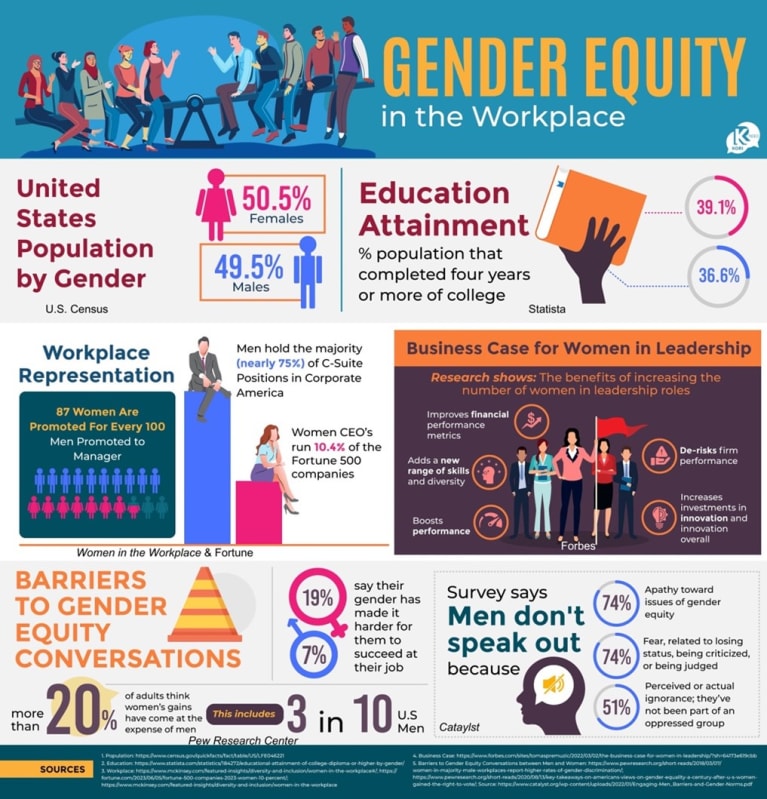In theory, business leaders—as skilled problem-solvers—collect data to make decisions and act on facts. But in truth, decisions are made that way only sometimes. Take the case for gender equity. Data overwhelmingly supports the idea that diversity of all types enhances workplace innovation and profitability. If the business case is so compelling, a question lingers like a glaring, unattended item on a meeting agenda: Why haven't we made more progress on gender equity?
More specifically, as a step to gain momentum, why haven't we engaged more men, who hold the majority of leadership positions in companies today, in gender equity discussions at the office?
Perhaps we need to add a touch of behavioral neuroscience to SHRM's Body of Applied Skills and Knowledge to better understand what is happening and how to address it. It's not that HR professionals need to be neuroscientists, biologists or psychologists, but they can understand the relationship between the brain, beliefs and behaviors. This is especially true when the data is strong, yet humans act counter to what the "facts" reveal.
Tali Sharot is a neuroscientist and professor at the University College in London who explained the issue this way when speaking at the 2017 World Economic Forum: "As a scientist, I used to think that the answer was data. Get data, coupled with logical thinking, that's bound to change minds, right? So, I went out to try and get said data. My colleagues and I conducted dozens of experiments to try and figure out what causes people to change their decisions, to update their beliefs, to rewrite their memories. We peeked into people's brains, we recorded bodily responses and we observed behavior.
"You can imagine my dismay when all of these experiments pointed to the fact that people are not, in fact, driven by facts. People adore data, but facts and figures often fail to change beliefs and behavior. The problem with an approach that prioritizes information is that it ignores what makes us human: Our desires, our fears, our emotions, our prior beliefs, our hope."
This quote caught my attention based on my own curiosity-driven research. I interviewed men about gender equity in the workplace after the height of #MeToo social media activity. At that time, the buzz had expanded to include all aspects of inequity, from harassment to pay and promotions. I observed that many of my female colleagues were speaking out, but the men, for the most part, remained silent.
At the time, I worked for a consumer packaged-goods company where research, insights and data were part of the everyday lingo. A friend encouraged me to avoid assumptions and ask the men what they thought about gender equity. I hired a professional researcher on my own dime, enlisted a trusted friend and we reached out to our professional network to talk to men. I followed with secondary research.
The data as presented in the infographic below is pretty clear. Women outnumber men by a sliver in terms of the U.S. population and by a few percentage points when it comes to attaining college-level degrees. But when it comes to earning promotions, men hold the majority of leadership positions. The business case for women in leadership is strong, and I have yet to meet a leader who ignores every reasonable, ethical way to improve growth, innovation and organizational effectiveness. In a results-driven, outcome-focused business environment, these metrics matter.

Despite the evidence, the U.S. ranks 43rd globally on the World Economic Forum gender parity index after dropping 16 places since 2022. The data is moving in the opposite direction of progress. Last year, CNBC reporter Yun Li cited Moody's Investors Service in reporting that "more women in the boardroom could drive higher credit ratings and stock returns for firms, but they hold just 29 percent of seats," an increase from 24 percent two years ago. Li also pointed out that anecdotally, the stocks of companies with low levels of female representation on their boards have underperformed.
Pam Harper, strategic growth advisor, speaker, author and founding partner of Business Advancement Inc. in New York, refers to the condition of staying the course—despite the existence of a better, more lucrative way—as the "orbit of status quo." Harper and her business partner, Scott Harper, host a podcast called "Growth Igniters® Radio," where they address the "Growth Igniters® Paradoxes," which are defined as statements that seem contradictory or the opposite of common sense but are held to be true.
Harper explained: "On one side of each paradox is the appeal of the rationally conceived new vision, strategies and objectives that promise substantial rewards. On the other side are complex human dynamic issues rooted in neurobiology. In essence, stakeholders often feel ambivalent about putting what has worked up-to-date at risk for unproven, albeit attractive, promises."
One example is the Growth Ignitor's Visionary Paradox, defined as the bolder the vision, the stronger the pushback. Harper said leaders agree that a compelling vision is a powerful tool for alignment, and there may be a mismatch with stakeholders who have their own biases, values, knowledge and experiences.
Let's apply this to gender equity. The business case is filled with strong data supporting women as leaders. The numbers also show that men occupy the majority of C-suite positions, yet why is the gender diversity and inclusion plan relegated to a lower level and not a key integrated growth strategy? As Sharot and Harper have alluded to, could it be that we need to address what makes us human: fears, emotions, prior beliefs, ambivalence, biases and individual experiences?
When I interviewed men, many of them said they get the business case for gender diversity on the macro level. They did not doubt it. What they were uncertain about, what remained ambiguous and complex for them to process, and why it was easier to say gender equity was a women's issue, was related to the impact of equity on them. Their uncertainty came in at the micro level, or, "What will happen to me and my job?"
For this reason, I decided during my research journey to switch from the word "equality" to "equity." Equality is an activity of giving everyone the same of everything. Equity, on the other hand, acknowledges that some groups already have an advantage. This back of the napkin drawing represents and reflects the shift in thinking and the spark for the theory of change.
Wilfried Krüger's Iceberg Change Management Model addresses organizational change by examining how managers deal with barriers. Using the iceberg as a metaphor, Krüger explained that many change managers only consider the top of the iceberg, meaning cost, quality and time; however, below the surface of the water, the iceberg is even bigger and represents barriers that include management of perceptions and beliefs as well as power and politics. In other words, Krüger said we must go under the surface and both acknowledge and get into the messy chaos if we want to change and achieve results.
The bottom of the iceberg could hold the key to momentum-gaining conversations about gender equity. Here, the conversations give a nod to both the data and the stuff that makes us human. This is where true change begins, engaging both men and women in a conversation for a better way that addresses our human emotions, too.
Kori Reed, SHRM-SCP, is the author of the book Men-in-the-Middle: Conversations to Gain Momentum with Gender Equity's Silent Majority (Pure Ink Press, 2023). Reed worked nearly 25 years in Fortune 500 companies, and her experience includes strategic corporate communication, human resources and integrated corporate social responsibility.
Advertisement
An organization run by AI is not a futuristic concept. Such technology is already a part of many workplaces and will continue to shape the labor market and HR. Here's how employers and employees can successfully manage generative AI and other AI-powered systems.
Advertisement



